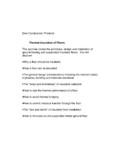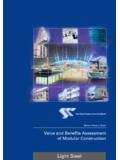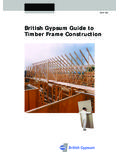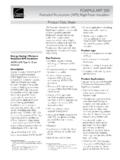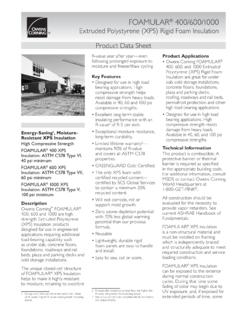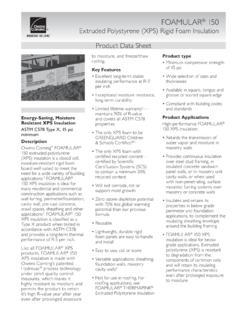Transcription of DOW CONSTRUCTION PRODUCTS - Design for …
1 DOW CONSTRUCTION PRODUCTS (a division of the Dow Chemical Company Ltd) INSULATED PITCHED ROOFING Welcome to this RIBA approved CPD self tutorial. First some information about the Dow Chemical Company itself: US origin, 100 years largest chemical company in the worldProduces: chemicals, plastics, sales: 18 : 45,000 globally (Europe 8,000) Dow in the UKSTYROFOAM* production since 1969 : polystyrene produced at Barry,Wales; extruded foam insulation produced in Kings Lynn. Dow CONSTRUCTION PRODUCTS offers the STYROFOAM range of blueextruded polystyrene foam insulation : Floors - Floormate* 200,350,500 and 700 Cavity Walls - Wallmate* CW Walls internally - Styrofoam* IB Structures below ground - Perimate* DI Pitched Roofs - Roofmate* PR, RL Inverted Flat Roofs - Roofmate* SL, LG Conventional Flat Roofs - Deckmate* CM, FF* Trademarks of the Dow Chemical Company Dow CONSTRUCTION ProductsInsulated Pitched RoofingThis self-tutorial seminar covers all aspects of the so called WarmRoof Concept at rafter level pitched roof will discover The insulation options The advantages of the warm versus the cold roof How a warm roof is constructed The general Design considerations.
2 Relevant codes of practice and applicable standards to adhere to The role and selection of the various components with particular emphasis on the insulation , the underlay, fasteners and methods of securement The relevance and importance of the building physics issues, thermal insulation , condensation and ventilation The ins and outs of detail Design : eaves, ridge, valley, hip and roof penetrations How the warm roof concept has been put to the test in the fieldINSULATED PITCHED ROOFINGINTRODUCTION:It is estimated that today around 10% of new pitchedroofs are insulated at rafter level and that thisfigure is insulation solutions are available which aredependent on the type of insulation used and itslocation ( ie above, between or below the rafters or acombination of these ), and the type of underlayused. Although the insulation of pitched roofs cannotbe considered a new application it is now the subjectof much debate both in the technical press and withinthe industry itself - indeed the BRE, NFRC and BSIare all actively aim of this seminar is to review the applicationfrom an insulant manufacturer s point of view.
3 insulation options Advantages of an insulated roof structure The Warm roof concept Design considerations Roof build-up: the components Building Regulations: requirements Case study Detailing ConclusionsCONTENTRoof structure: uninsulatedattic/loftspaceinsulation atceiling level insulation at ceiling / joist level - mineral / glass fibre normally used attic / loft space ventilated (vents provided at eaves and at ridge)Note: Could adequate ventilation be provided by awater vapour permeable (breather) underlay andthus do away with providing vents at eaves andridge level ?Roof structure: insulatedroom inthe roofinsulation atrafter level insulation can be a) above, b) between c) below the rafters or a combination of these Warm roof insulation above rafters sometimes referred to as sarking insulation (see BRE Thermal insulation : avoiding risks BR262 Hybrid roof : insulation between and/or under : Focus of this seminar will be on the warm pitched roof as this is theoptimum ( and perhaps the most challenging ) of the insulation : INSULATED VSUNINSULATED ROOF STRUCTURE Increased living /working space for same footprint Additional space at lower cost Added value Allows room to grow Cost of providing additional space in the attic can be less than 50% of the standard floor cost.
4 Plus ----- with a warm roof: - reduced risk of condensation on structural membranes. - thermal movement of roof structure reduced. - roof structure kept dry - no need for timber preservative WARM PITCHED ROOFR afterTiling battenTilesCounterbattenInsulationVapour permeableunderlay - roof build up insulation shown above and between rafters Vapour permeable underlay (breather type) can be laid either in direct contact with the insulation ( as shown ) or over the counterbattens Suitable for new build or where the roof covering is to be replaced ( note increase in roof height ! ) and where it would be difficult to provide eaves ventilationNote: Need for a vapour control layer (VCL) ? YES for areas exposed to high humidity levels swimming pools, kitchens, changing rooms. Use plasterboard (13 mm) to cover exposed XPS WARM PITCHED ROOF CONCEPT rigid insulation over (and between) rafters plus a water vapour permeable (breather) underlayNote: Where proprietary PRODUCTS are to be specified,manufacturers recommendations should be should satisfy themselves that the performance ofthese PRODUCTS and the given recommendations have beenproven by relevant experience in use or by test data basedon the conditions and methods of application in equivalentand appropriate internal and external climatic WARM PITCHED ROOF First.
5 Thatched roofing ! Developed from Scottish sarking - early 80 s Agr ment certification - mid 80 s Thousands roofs, millions sq metres installed Includes all insulation types Minimal condensation problems No securement problems Note: Thatched roof - really is a breathing warm roof Sarking - originated in Germany / Scandinavia refers to a sheet or underskirt of boarding. - traditionally in Scotland 25mm thick close timber boarding at underslating level. - helps reduce effect of wind uplift on considerations!BS 5268 : Part 7 : 1990 Roofconstruction - rafters & purlins(Approved Document A : 1994 )!BS 5534 : Part 1 : 1997 Slating & tiling!BS 6399 : Part 1 : 1984 Dead loading!BS 6399 : Part 2 : 1995 Wind loading!BS 6399 : Part 3 : 1988 Imposed &snow loading ROOF BUILD-UP - THE COMPONENTS Rafters Vapour Control Layer insulation Underlay Battens FastenersRAFTERSC onsider: Roof slope Cut vs trussed Dimensions (and tolerances) Spacing Bracing Note:Must assume that insulation does not contribute tothe racking strength of roof CONTROL LAYER (VCL) Usually a membrane (eg 500 gauge polyethylene sheet) Substantially reduces transfer of water vapour Installed on warm side of insulationA VCL reduces water vapour transfer through any building component inwhich it is incorporated.
6 (BRE document BR 262: Thermal insulation - avoiding risks specifies aminimum water vapour resistance of 200 MNs/g. BS 5250 refers to the useof 500 gauge polyethylene with a range of 200 to 350 MNs/g, typically 250 MNs/g.)The VCL should be installed on the warm side of the insulation . ( Note that aVCL at ceiling level will require increased ventilation below it during the wettrade phases of CONSTRUCTION .)Performance of a VCL also is dependant on workmanship and build ability -see Clause of BS is essential that it is adequately lapped and sealed so as to maintain care should be given to detail Design and installation aroundpenetrations through the VCL ( services, compartment walls) and to thesealing of punctures caused by Location - above / between / below (or any combination) Selection - thermal performance - water vapour permeability - water resistance (absorption) - user friendliness Thickness Installation - thermal integrity - convection tightLocation:(a) over the rafters(b) between the rafters(c) under the raftersor any combination of theseNote.
7 Option (a) is sometimes referred to as a warm roof CONSTRUCTION or as sarking options can be used for new roof constructions or where the roof is to bereplaced from rafter level options (b) and (c) can be used in situations where the roof covering cannot be removed or :Rigid, semi-rigid and flexible insulants can be used. Each has its own specificphysical characteristics as regards performance and installation requirements -the manufacturers recommendations should be followed. cont ->Thickness:The thickness of the insulation will be determined by the required thermalperformance as well as by the roof CONSTRUCTION (see Approved DocumentL). It is important to ensure the continuity of the thermal insulation . If thisis broken eg by the rafters and /or penetrations through the roof, theresulting thermal bridges can increase the risk of localised condensationand pattern staining of ceilings at rafter : Building Regulations require the effect of thermal bridging to betaken into account when calculating the thermal performance (U-value) ofthe roof.
8 Refer to BS 5250 Section and BRE Document 262: Thermalinsulation - avoiding :Thermal integrity is roof void should be completely insulated. For example gable endwalls will need to be insulated to their full height. The designer should take care to ensure that there are no gaps or breaksin the insulation insulation should be installed to fit tightly at ridges, at eaves andaround penetrations. Seal if necessary with flexible (polyethylene) or boards should fit tightly together with no gaps around board joints should be correctly positioned so as to shed any likelyincoming external water. Some types of board will require their joints tobe sealed with tape - refer to the manufacturers care needs to be taken with rebated boards designed for over andbetween rafter installation Roofmate PR to ensure that the rafterspacing is accurately set out so as to avoid gaps or unnecessary cutting tight/airtight:A roof system in which the free movement of air through any section of theconstruction is prevented by use of airtight joints and seals is said to be convection tight or airtight.
9 insulation - typical physical properties XPSEPSPURMFT hermal vapour resistance(relative to MF) -14060801 Water vapour resi st ivit yMNs/gm 10003006005 Water absorption% strengthkPa 300+190max 175max120maxDensitykg/m33015-3030180 XPS - extruded foamed polystyrene EPS - expanded foamed polystyrene (bead board) PUR - polyurethane/polyisocyanurate MF - mineral fibre Thermal conductivityXPS, EPS measured at 90 days (after equilibrium reached) - long term measured immediately after production ie before equilibriumreached - short term value. Water vapour resistanceDetermined relative to MF(air) for equivalent U-value thicknesses (XPS=50mm) Water absorption Be sure to take into account likely effect on thermal conductivity !ROOFMATE* RL, PR- physical characteristicsPR RLDensity kg/m334 34 Thermal conductivity strength kN/m2300 300 Water absorption % vapour resistivity MNs/gm 940 940 Board size mm 2500 x 600 2500 x 600 Thickness mm 80, 90, 120 35, 50 Edge profile -rebated tongue & groove Roofmate RLTongue and groove on all should be laid so the tongues in horizontal joints face up the slope.
10 Roofmate PRAvailable with edge flanged to suit 38 and 50mm rafters - type 38 and should be laid so that horizontal lap joints ( top and bottom of boards)point down the slope so that boards higher up the roof overlap those furtherdown (boards are marked so as to facilitate this with an arrow pointing up theslope of the roof).UNDERLAYS-REQUIREMENTS- TRADITIONAL Keep water (snow, dust) out Air tight Adequate strength- WATER VAPOUR PERMEABLE (Breather) As Traditional plus water vapour permeability Keep water etc. out - secondary defense against wind driven rain, snow and dust. Air tight - to reduce wind load on primary roof covering. Adequate strength - tensile, tear strength (for nails), extensibility (reduce movement under wind pressure). Working temp.
